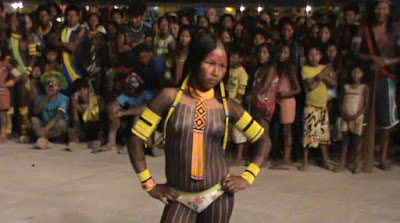In a make-shift editing room in Belém, Brazil, seven aspiring Kayapó filmmakers hunch over laptops viewing footage shot during the prior year. These young men, representing three Mebengokre-Kayapó villages, are part of a Goeldi Museum project funded by Brazil’s National Research Council (CNPq) that is providing indigenous communities with equipment and training in digital film production. After three days of editing, the novice cinematographers are ready to screen their first films.
Some, such as the Woman’s Festival and Belo Monte Dam Protest are examples of what Terence Turner calls “cultural performance,” a staple element in indigenous-made films.[i] Others focus on less usual topics: a professional soccer game in Rio de Janeiro and a local health worker’s explicit presentation on STDs.
The most intriguing work, however, is Miss Kayapó, a forty-minute documentary about a beauty contest held yearly in a Brazilian town near Kayapó territory.
Some, such as the Woman’s Festival and Belo Monte Dam Protest are examples of what Terence Turner calls “cultural performance,” a staple element in indigenous-made films.[i] Others focus on less usual topics: a professional soccer game in Rio de Janeiro and a local health worker’s explicit presentation on STDs.
The most intriguing work, however, is Miss Kayapó, a forty-minute documentary about a beauty contest held yearly in a Brazilian town near Kayapó territory.
 |
| A video still from "Miss Kayapó" |
With a backdrop of São João carnival fairgrounds, neon-lit Ferris wheels, and a country band warming up, adolescent Kayapó girls saunter one-by-one around a makeshift runway painted in chalk on the dusty ground. As during traditional Kayapó dance festivals, the girls wear long bead necklaces, wide bracelets, and brightly colored bikini underwear. Their bare torsos are decorated with elaborate geometric patterns in black Genipa.
Far from traditional, however, is the girls' deliberately swaying gait, punctuated by a dramatic pause at each corner of the chalk runway, hands on cocked hips, with pouting lips and a sultry tilt of the head. This erotic body language, which they have learned from watching fashion models on Brazilian TV, is a far cry from the collective feminine stomping of traditional Kayapó dance performance.
Before the beauty contest, villagers perform a traditional dance on the fairground
|
The clash of cultural traditions captured in Miss Kayapó raises a troublesome question: is the film self-degrading, subverting native self-understandings and aping Western paradigms in the worst possible way?[ii]
Not if you ask Tatajere and Pymare, the film’s creators: “We are showing Kayapó beauty to all Brazilians.”
 |
| The Menire Biok festival celebrates traditional notions of feminine power and beauty |
